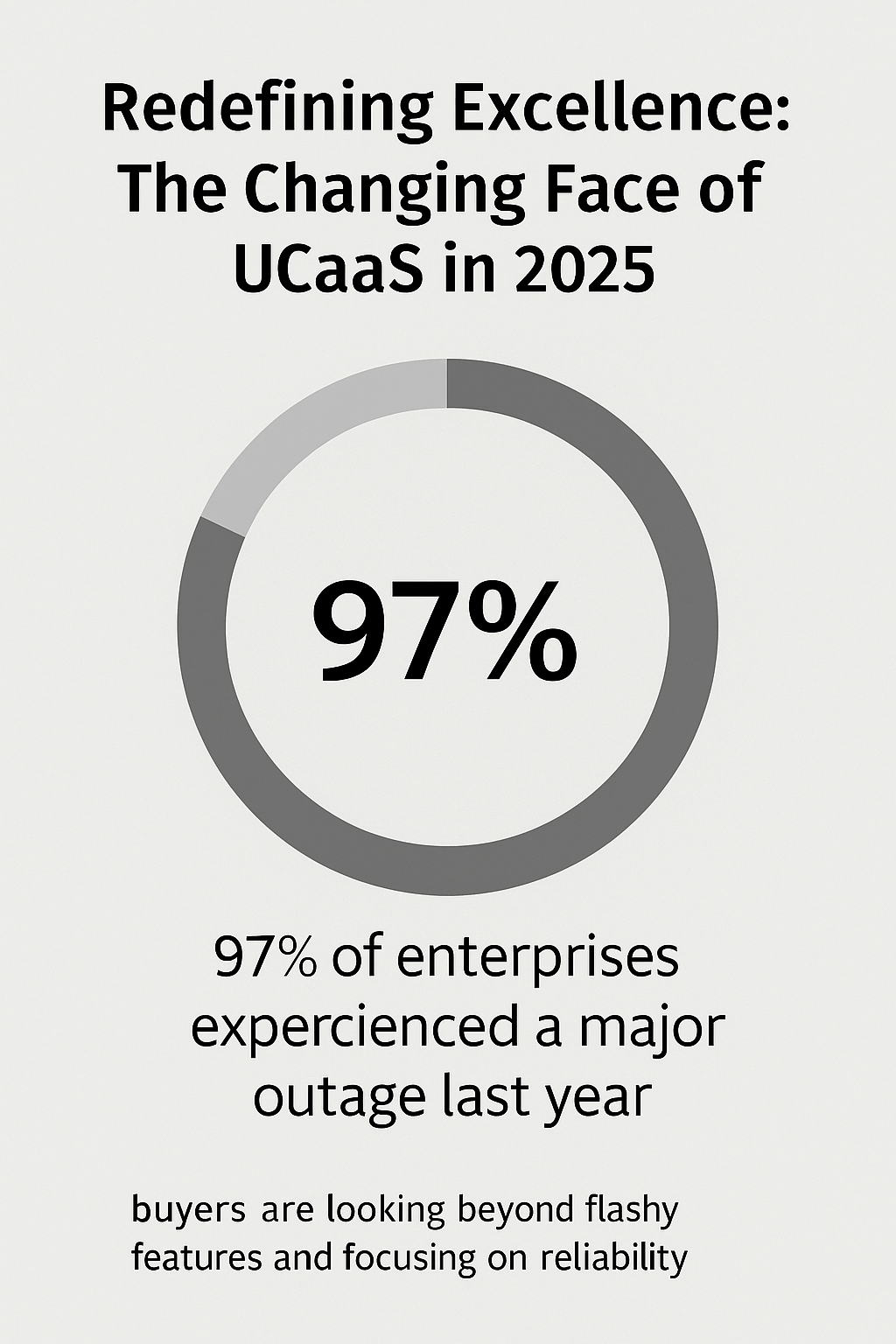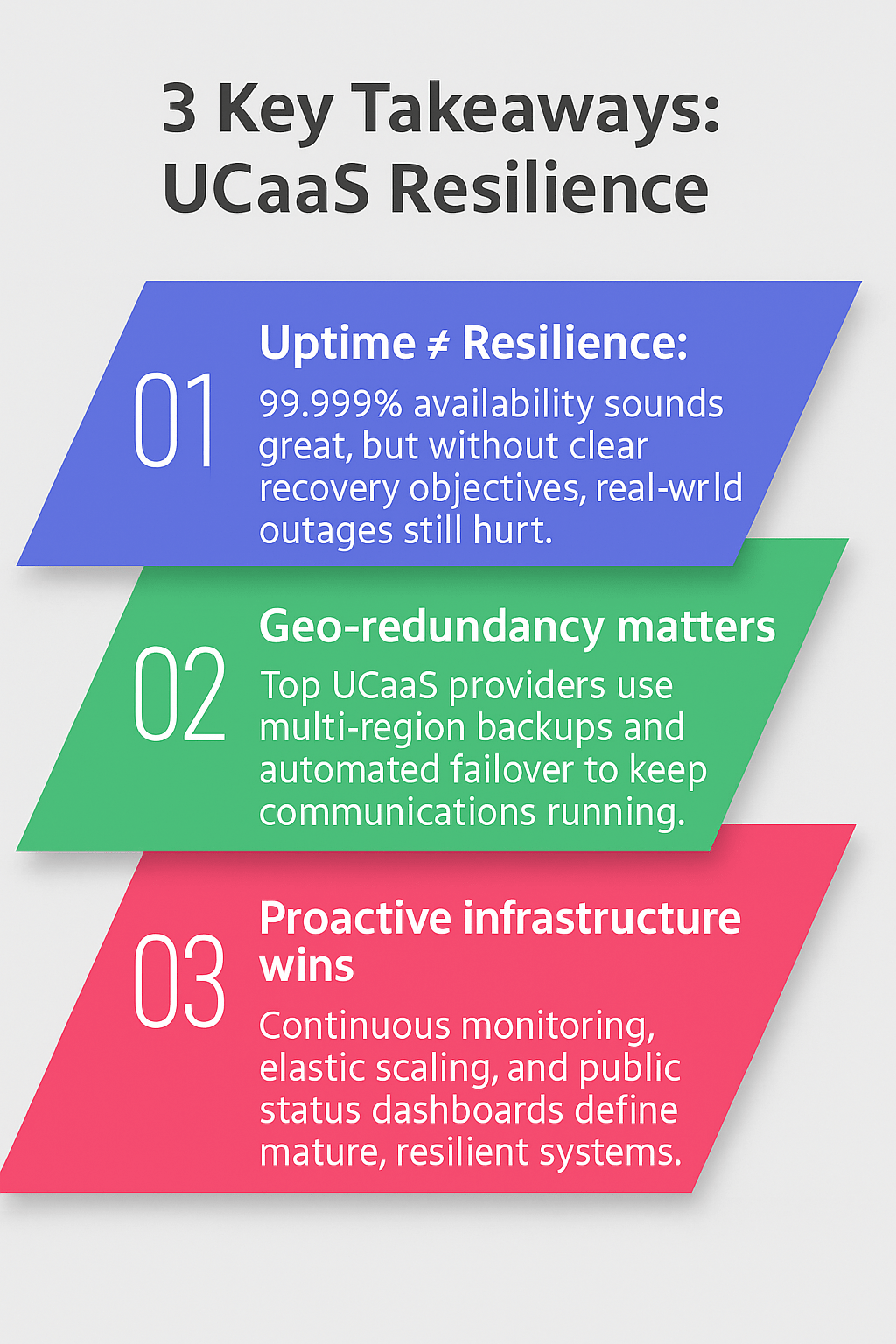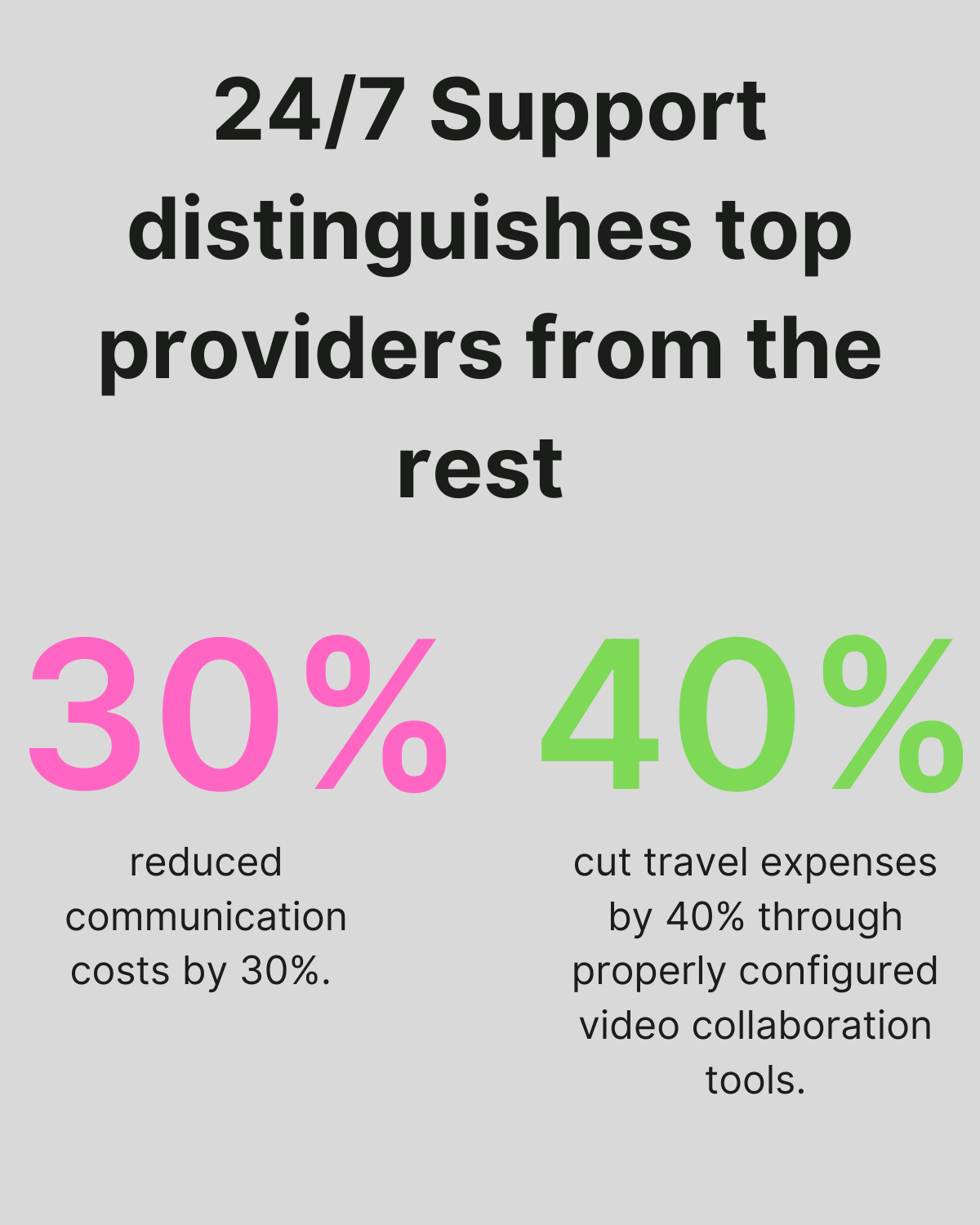Last spring, I spoke with the IT director of a mid-sized healthcare group who had just switched UCaaS providers, for the third time in two years. Each transition came with confident promises: better uptime, richer features, smoother onboarding. None of them delivered. What finally worked was a lesser-known provider with deep healthcare experience and reliable, human support. That story isn’t unique; it’s quietly becoming the norm.
This article unpacks that shift. You’ll learn why smaller UCaaS providers often deliver better outcomes, what signals actually predict success, and how to evaluate vendors based on what matters, not just what they claim.
Redefining Excellence: The Changing Face of UCaaS in 2025
The UCaaS market reached $20.6 billion in 2023 and is projected to grow to $172.69 billion by 2030. But in a space dominated by brand visibility, nearly 97% of enterprises still experienced at least one major outage last year.
That disconnect has sparked a shift: smart buyers are rethinking what “best” really means. Instead of flashy feature sets or marketing muscle, they’re prioritizing long-term fit, vertical-specific expertise, and resilience in the real world.

What truly defines the best UCaaS providers in 2025?
While established players continue to dominate market conversations, emerging UCaaS vendors quietly excel in areas that matter most: implementation support, industry-specific compliance knowledge, and responsive customer service.
These factors increasingly drive purchasing decisions as organizations prioritize partners who understand their unique operational challenges.
Buyers frequently overlook critical performance indicators when evaluating options. Service uptime statistics, migration success rates, and integration capabilities often reveal more about provider quality than glossy marketing materials. The most successful organizations now assess UCaaS trends through the lens of operational fit rather than market position.
This shift creates opportunities for specialized providers who deliver tailored solutions that precisely match business requirements, a capability that transcends mere size or market presence.
Rethinking What Best Means in UCaaS
Businesses frequently select UCaaS providers based on their market position. This assumption creates expectations that reality rarely matches. The global UCaaS market value reached $20.6 billion in 2023. Growth climbed by 8.8% year-over-year, according to UCaaS market size and growth. Customer satisfaction and service reliability rarely correlate with these impressive numbers.
When Reputation Doesn’t Equal Reliability
Consider a mid-sized healthcare group that switched providers after experiencing three major service disruptions within six months. Their tier-one provider left critical patient communications and scheduling systems vulnerable.
NETSCOUT on UCaaS outages: 97% of enterprises faced at least one major UCaaS outage in 2023. Financial losses exceeded $10,000 per incident for 64% of affected companies. The healthcare group found its solution by partnering with a smaller, healthcare-focused provider offering specialized compliance knowledge and redundant infrastructure.
Effective UCaaS selection requires looking beyond promotional materials toward practical performance metrics. Begin by conducting a communication audit that aligns your specific requirements with provider capabilities.
Focus on uptime guarantees, industry expertise, and support responsiveness rather than market rankings.
Looking Beyond Market Share
Statistics about market position often obscure significant differences in customer retention rates. Smaller providers typically maintain retention rates 15-20% higher than industry giants through personalized support and flexibility.
These companies adapt to customer feedback quickly, often implementing requested features within weeks instead of quarters. Such responsiveness creates value that exceeds what market position rankings suggest.
What Modern Buyers Are Really Prioritizing in 2025
Purchasing decisions for communication platforms have shifted dramatically in recent years. Modern buyers now focus on interoperability and long-term fit rather than extensive feature lists. This change reflects a deeper understanding of how these systems integrate with existing technology stacks.
In 2025, the market will reach approximately $28.5 billion this year. Nearly 58% of workers now operate remotely, using digital communication tools up to 20 hours weekly. Such widespread adoption has transformed evaluation criteria for organizations seeking new solutions.
Forward-thinking IT leaders assess providers through four critical lenses: infrastructure ownership (control of data centers), hybrid capabilities (combined communication and contact center functions), security governance frameworks, and managed service options. The 2025 AVANT UCaaS State of Disruption Report highlights how security and interoperability have become primary decision drivers as companies move from legacy systems to more integrated platforms.
A manufacturing company’s IT director recently told me about their decision to move away from a well-known vendor in favor of a specialized provider with deep integration capabilities. Their choice came down to manufacturing-specific workflows and superior API documentation for ERP systems. The impact? Fewer support issues and noticeably smoother communication across teams. It was a reminder that vertical fit often outperforms generic feature lists.
To simplify your evaluation process and ensure you select the right communication partner, here’s a practical framework worth following:
- Assess AI capabilities, mobile support, and scalability options for your specific needs
- Verify reliability through SLAs and network redundancy documentation
- Evaluate support quality via 24/7 availability and dedicated account management
- Review performance transparency through public status pages and metrics
- Calculate the total cost of ownership while identifying potential hidden fees
- Align communication features with your business objectives
- Follow a structured approach: audit needs, map features, test support, calculate ROI
This UCaaS provider evaluation framework helps organizations prioritize interoperability factors that matter most for sustainable success rather than getting distracted by flashy but ultimately unnecessary features.
Signals of Performance Most Lists Ignore
Glossy marketing materials highlight feature sets. Savvy buyers dig deeper into service quality indicators beyond standard rankings. The global UCaaS market reached $48.79 billion in 2023, creating a crowded field where providers make nearly identical reliability claims.
Migration Success Is a Real Test
Last year, our team watched a healthcare client struggle for weeks with a vendor whose migration specialists disappeared after the sale. Vendors offering structured onboarding processes and dedicated migration teams deliver smoother transitions.
About 37% of businesses utilize UCaaS solutions according to Metrigy, yet many face implementation challenges from inadequate support. Case resolution statistics and average response times during setup phases often predict future support quality.
Customer-led innovation serves as another powerful performance signal. Transparent development processes, customer advisory boards, and public feature request systems demonstrate a vendor’s commitment to evolving based on actual user needs rather than following market trends without customer input.
Key UCaaS performance metrics extend beyond uptime percentages. Comprehensive analytics should track call quality scores, network delays, and adoption rates. Proactive monitoring systems that detect issues before users report problems show technical maturity. The best analytics platforms provide actionable insights through sentiment analysis, helping organizations optimize communication systems continuously.
Resilience Beyond Reach
Uptime guarantees rarely match real-world recovery experiences. UCaaS providers often promote 99.999% availability. This translates to merely five minutes of annual downtime. Yet contracts typically lack specific recovery time objectives. Organizations that depend on communications for revenue face substantial risk when service disruptions occur.
True resilience requires geographic redundancy in UCaaS architecture. Geo-redundant backups allow for the duplication of critical infrastructure across multiple regions, safeguarding against localized failures.
When selecting providers, request documentation about data center locations. Ask about automated failover mechanisms and regional isolation protocols. Demand specific remediation timelines in SLAs with meaningful financial penalties rather than minimal credits.
Disaster recovery planning remains one of the clearest indicators of real resilience. Organizations without a documented and regularly tested recovery process face much greater risk when outages occur. In contrast, those using modern, cloud-based recovery tools consistently report shorter downtimes and faster restoration of critical operations.
Cloud-native UCaaS scalability establishes the foundation for robust recovery systems. Modern architectures use elastic resource allocation to maintain service during disruptions.
Leading providers implement capacity planning analytics to identify potential bottlenecks before performance suffers. These systems monitor network health continuously. They automatically reroute traffic when degradation occurs. Public status dashboards provide transparency during incidents, ensuring communications remain operational under challenging conditions.

Support That Scales with Your Business
A healthcare provider recently shared their migration experience with us. Their vendor’s deployment team created custom training modules for clinical staff. This resulted in 92% user adoption within just two weeks, transforming a potentially disruptive transition into a strategic advantage.
Migration planning forms the foundation of effective deployment guidance. Network assessments and user training strategies complete this foundation. Providers with varying support capabilities have entered the market as UCaaS grows toward $215.53 billion by 2032.
24/7 support distinguishes top providers from the rest. When evaluating options, verify support team locations and average response times. Check escalation procedures for urgent issues. Dedicated account managers who understand your industry create valuable continuity throughout your relationship.
This specialized knowledge becomes particularly important considering industry trends. Over 95% of businesses recognize the importance of UCaaS and CCaaS integration. Implementing these integrations requires expert guidance for maximum benefit.
Financial impacts appear clearly in real-world UCaaS success stories. A law firm working with thorough vendor support reduced communication costs by 30%. They simultaneously increased billable hours by 25%. Similarly, a manufacturer cut travel expenses by 40% through properly configured video collaboration tools.
Providers Gaining Ground Quietly in the US
Several nimble UCaaS providers are steadily expanding their market share through exceptional service and offering compelling alternatives beyond mainstream options. They excel in vertical-specific deployments, where larger vendors fall short. One example is PanTerra, which delivers HIPAA-compliant workflows for medical practices.
Last quarter, I spoke with a regional bank CIO who shared a surprising discovery. After switching from a market leader to a niche UCaaS vendor, support tickets dropped by 40 percent and user satisfaction scores improved dramatically.
Frost Radar analysis confirms niche UCaaS vendors adapt quickly to diverse customer requirements. Many support hybrid work models with tailored solutions rather than one-size-fits-all approaches.

Choosing the Right UCaaS Partner Starts with Fit
By this point, it’s clear: choosing a UCaaS provider is about finding a partner that understands how your business operates.
Good decisions begin with better questions. Does the platform integrate with your systems? Will the support team understand your industry context when something goes wrong? Have they worked with teams like yours before?
Strong providers reduce friction, improve clarity, and strengthen how your organization communicates every day.
UCaaS Reviewer exists to help you make those decisions with confidence. We offer expert comparisons and practical insights to guide your search, whether you’re switching platforms or building your communication stack from the ground up.
Take your time. Start small. Focus on what matters.



